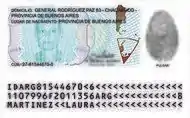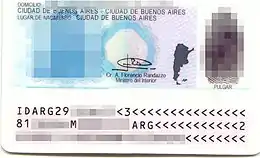Documento Nacional de Identidad (Argentina)
Documento Nacional de Identidad or DNI[1] (which means National Identity Document[2]) is the main identity document for Argentine citizens, as well as temporary or permanent resident aliens (DNI Extranjero). It is issued at a person's birth, and must be updated at 8 and 14 years of age, and thereafter every 15 years. It takes the form of a card (DNI tarjeta), and is required for voting, payments, military service inscriptions and formalities. They are produced by the Argentine National Registry of People.
| Argentine identity card (Documento nacional de identidad) | |
|---|---|
 Documento Nacional de Identidad | |
 Reverse | |
| Type | Identity card |
| Issued by | |
| Purpose | Proof of identity |
| Valid in | |
| Eligibility | Argentine citizenship and lawful permanent residents |
The front side of the card states, in both English and Spanish, the name, sex, nationality, specimen issue, date of birth, date of issue, date of expiry, and transaction number along with the DNI number, portrait, and signature of the card's bearer. The back side of the card shows the address of the card's bearer along with their right thumbprint. The front side of the card also shows a PDF417 barcode while the back shows machine-readable information. The unique DNI number is semi-perforated through the front-right side of the card.
The DNI is a valid international travel document to enter the member countries of Mercosur (Brazil, Paraguay, Uruguay and Venezuela) and countries associated to the bloc (Bolivia, Chile, Colombia, Ecuador and Peru).[3]
Before the introduction of the DNI in 1968, women had a Libreta cívica ("civic booklet"); men a Libreta de enrolamiento ("(military) enrollment booklet").[4][5] For many years, the DNI was issued as a small green booklet (called libreta). In 2009, the DNI was revamped and digitalized; and booklets (now blue) were issued along with an identity card simultaneously. Since 2012, DNIs are issued only in card format. The new DNI card is required to obtain the new biometric Argentine passport. Foreigners can get it at “RadEx” system but "extranjero" (foreigner) is printed on the back side. Argentines can get a certificado de matrícula, which is only for citizens, in consulates.[6]
In 2020, the DNI card was restyled to show the new bicontinental official map of Argentina.[7][8]
Gallery
 Front side of previous version of DNI card, issued 2012-2020
Front side of previous version of DNI card, issued 2012-2020 Back side of previous version of DNI card, issued 2012-2020
Back side of previous version of DNI card, issued 2012-2020 Front side of previous version of DNI card, issued 2009-2012
Front side of previous version of DNI card, issued 2009-2012 DNI blue booklet, issued 2009-2012
DNI blue booklet, issued 2009-2012 Previous green libreta version of the DNI, issued 1968-2009, until the new DNI cards began to be issued
Previous green libreta version of the DNI, issued 1968-2009, until the new DNI cards began to be issued
See also
References
- Nuevo DNI, Ministry of the Interior of Argentina, retrieved June 14, 2011
- New National Identity Document unveiled, Télam, archived from the original on August 15, 2011, retrieved June 14, 2011
- "Mercosur will not ask their South American members passport". Mendoza Travel. Retrieved 2017-06-09.
- Libreta de enrolamiento of Julio Cortázar Archived March 27, 2012, at the Wayback Machine
- Argentine government website: How Argentine citizens abroad can apply for a DNI with an existing Libreta cívica or Libreta de enrolamiento Archived August 4, 2011, at the Wayback Machine (in Spanish)
- "Consulado General en Vigo | Inscripción Consular". cvigo.cancilleria.gob.ar. Retrieved 2020-02-19.
- "El Gobierno lanzó un nuevo DNI: qué pasará con las versiones anteriores". La Nación (in Spanish). 25 November 2020.
- "Wado y Filmus presentaron el nuevo DNI que incluye una actualización del mapa bicontinental argentino". Argentina.gob.ar (in Spanish). Ministry of the Interior (Argentina). 20 November 2020.